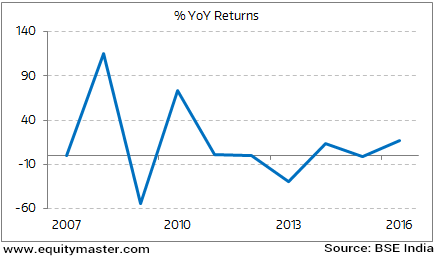- Home
- Todays Market
- Indian Stock Market News February 2, 2017
Sensex Trades Flat; IT Sector Witness Buying Thu, 2 Feb 01:30 pm
After opening the day on a flat note, the Indian share markets continue to remain range bound and is trading marginally above the dotted line. Sectoral indices are trading on a mixed note, with stock in the auto sector and the metal sector witnessing selling. Stocks in the IT sector and the consumer durables sector are leading the gains.
The BSE Sensex is trading up 40 points (up 0.1%) and the NSE Nifty is trading flat. Meanwhile, the BSE Mid Cap index is trading up by 0.8%, while the BSE Small Cap index is trading up by 0.9%. The rupee is trading at 67.49 to the US$.
The US Federal Reserve has left its key interest rate unchanged at a time of solid economic gains but also heightened uncertainty surrounding the new Trump administration. The federal reserve held the line on interest rates, in its meeting though it did give a nod to growing optimism among the business community and consumers.
The Federal Open Market Committee (FOMC) - the US central bank's policy making arm - kept its benchmark overnight lending rate target at a range of 0.5% to 0.75%. In December, the Fed raised the target a quarter point, or 25 basis points, marking just the second hike in more than 10 years.
The FOMC said in a statement ending its latest policy meeting that the job market has continued to strengthen, inflation has climbed closer to its 2% target and economic activity remains steady. But it signaled that it wants more time to monitor the economy and that it still envisions a gradual pace of rate increases. It offered no hints about when it will resume raising rates, as it had mentioned in the December 2016 meeting.
A quick succession of rate hikes would create a massive storm in the global financial markets. However, a pause in rate hike would lay the ground for much bigger financial storms later. Sooner or later, there will be an end to easy money policies. And that will lead to some big trends. Here's Asad Dossani, editor at Profit Hunter:
- Regardless how many more times interest rates go up, one thing is clear. This is the beginning of the end of easy money. At least, the end of easy dollars (easy euros, pounds, and yen will stay with us for a while).
As per Asad, the Fed's promise of more interest rate increases will lead to the end of easy money and will create big trends next year that traders can profit from.
Meanwhile, the Bank of Japan too did not change interest rates for the country. Keeping them steady at a negative rate of -0.1%.
Moving on to news from stocks in the oil and gas sector. The government plans to merge state oil companies to create an integrated oil major that could top US$ 100 billion in market value and compete with global oil biggies.
The proposal of merging 13 government oil companies, which had stemmed out of the Cabinet Secretariat last year but did not find takers in the ministry of petroleum, is now back on the agenda.
The Finance Minister, in his budget speech said that the government sees opportunities in strengthening public sector undertakings through consolidations, mergers and acquisitions. The FM also highlighted that opportunities of restructuring and consolidation are clearly visible in the oil and gas sector.
The government envisions the creation of an integrated public sector 'oil major' which will be able to match the performance of international and domestic private sector oil and gas companies.
The resulting entity from the consolidation of India's major oil & gas PSUs will create an oil major which could top over US$ 100 billion in market revenue.
The top eight listed state oil firms have a market value of US$ 108 billion, which dwarfs the US$ 50 billion of Reliance Industries, US$ 70 billion of Russia's Rosneft and is closer to BP's US$ 115 billion.
Consolidation to Lift the Oil and Gas Sector?

One of the key requirements would be the legislative changes needed to alter the structure of Hindustan Petroleum Corporation (HPCL) and Bharat Petroleum Corporation (BPCL), which were nationalised through a law approved by Parliament.
Another legal hurdle in merging the major oil & gas players would be the provisions of the Competition Act, which prevents the creation of monopolies in any business or sector.
Indian Oil Corporation, HPCL and BPCL among themselves control more than 90% of the domestic market for petroleum products. Their merger would mean a single entity controlling the mammoth market even if different brands are retained.
The only window available to the government is a little-used provision in the Competition Act which allows it to exempt enterprises from the competition law in "public interest" and "national security".
Consolidation of this scale will help strengthen the oil and gas sector, as the companies stand to benefit from each other's strengths as well as negating their shortcomings.
It remains to be seen how the government moves forward with this proposal. The short term and long term implications of a merger of this scale will be a key thing to watch out for.
For information on how to pick stocks that have the potential to deliver big returns, download our special report now!
Read the latest Market Commentary


Equitymaster requests your view! Post a comment on "Sensex Trades Flat; IT Sector Witness Buying". Click here!
Comments are moderated by Equitymaster, in accordance with the Terms of Use, and may not appear
on this article until they have been reviewed and deemed appropriate for posting.
In the meantime, you may want to share this article with your friends!